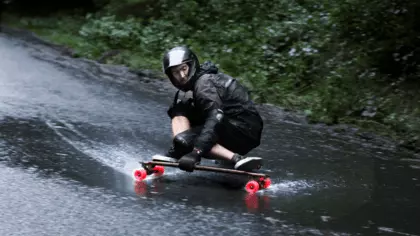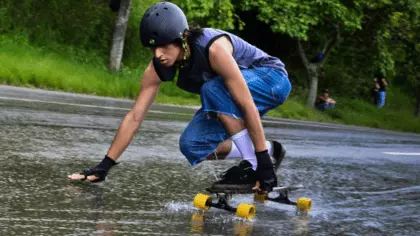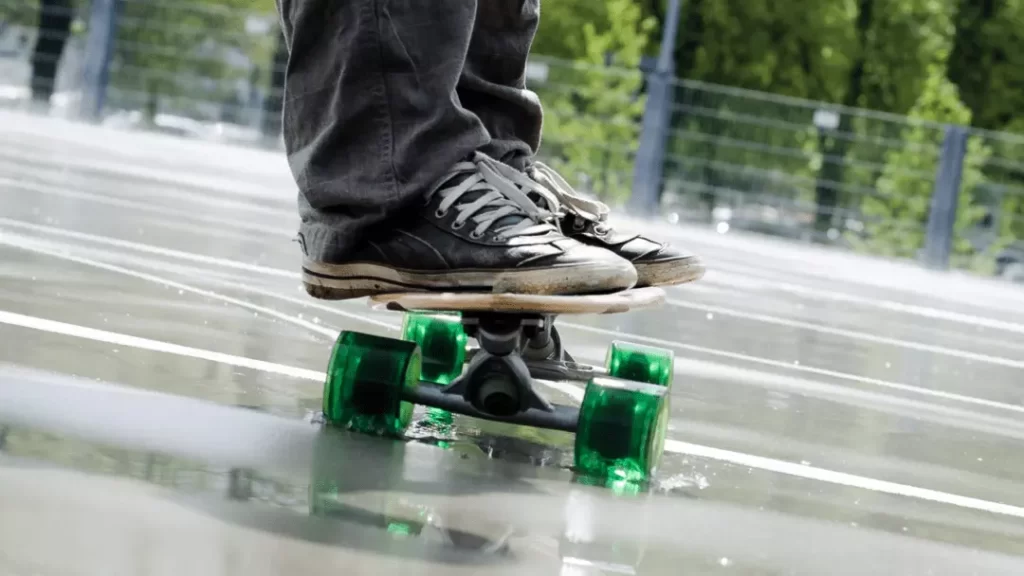According to ScienceDirect, between 2006 and 2016, around 12,920 children were injured due to riding longboards. Many of them had traumatic brain injuries (TBI).If this is the case on a normal day, what would happen in rainy weather? Can you ride a longboard in the rain? Can you make it safe to ride a longboard in the rain?
Still, you can. Longboarding can be done in the rain using the appropriate setup, protective clothes, and skill. According to the same study, the majority of them did not wear a helmet.Read on to discover the possibility, and process of longboarding in the rain, along with relevant tips.
Can You Ride a Longboard in the Rain?

Yes, you can ride a longboard in the rain only after taking some crucial precautions and following the right techniques. It means you should pick the right longboard with better wheels and bearings.
Safety gear like helmets, clothes, safety pads, and slip-resistant shoes are also very essential to remaining safe while riding in the rain. In addition, you must be extra careful while attempting various riding tricks; however, rain makes the surface quite smoother. It’s not the end.
You have to dry the longboard and clean all its parts properly after riding in the rain to preserve its functionality and longevity and keep it ready for the next ride. Taking all of these precautions will result in a thrilling ride, improved skill and strength, and perfected flows.
How to Longboard in the Rain Safely and Perfectly?

If you are keen to enjoy the thrill and take on the challenge of riding in the rain, follow these tips to make your longboarding as safe and comfortable as possible:
Before Riding Your Longboard
To avoid having to maintain your high-end longboard on a regular basis, separate a cheap longboard for riding only in the rain. Though the longboard can be cheaper, it should have better wheels and bearings and be scratch-free. Otherwise, if the deck has scratches, it can tend to warp more quickly than a fresh deck, which can be prevented by sealing.
In terms of type, a top-mount longboard will be the best bet. Instead, you can use a standard longboard that covers a minimum part of the wheels with waterproofing to avoid suffering. In this case, you can use water-resistant paint, floor sealer, or shoe repellent.
Wear regular clothes instead of expensive ones because they will get soaked, dirty, and soil while riding in the rain. Wearing slip-defying shoes can help you control the longboard with your feet more conveniently. Your longboard’s wheels may experience steady traction while riding on a soggy road. Hence, you should either buy a set of rain-adapted wheels or DIY them at home. Lastly, don’t ride your longboard in heavy rain.
Also Read: Why Do Skaters Wear Baggy Clothes?
During Riding on a Rainy Day
Safety pads and helmets are a top priority for rainy-day riding to protect your hands and head from risk. Avoid riding in front of a puddle in the rain to prevent getting excessive water on the board and bearing. More importantly, you can’t imagine what is inside the puddle. Your seemingly innocuous puddle may contain cobblestones or a large gap, causing you to collide hard.
In addition, be extra careful with curvy turns when riding a longboard in the rain. You should also be very aware of your surroundings, including painted lines or turning signals on the road, as these could cause you to off-board eventually. Remember that everything on the road can be dangerous in the rain.
Another helpful tip is to prevent letting the longboard run away from you. Don’t let the water enter the deck. If you notice something like this, go home. Continuing to ride in the rain may allow water to enter the wood and eventually damage the board.
If you bend out terribly during whirling, the board may slip out from under your feet. As a result, try to place your weight’s axis on the board’s top. Crook your knees and turn using your ankles rather than your weight one at a time.
After Riding in the Rain
After riding the longboard in the rain, disassemble it and dry it immediately. Remove the wheels, bearings, and other parts, and start drying the hearth rug. In this case, you can use the tepid air of your hair dryer to dry the deck and other components.
Unbolt the kingpin to prevent rust and spend a few bucks on a replacement. If the kingpin causes rust, you won’t be able to slack off or tighten the trucks. Though the whole board won’t dry completely, aerate it using a dryer to keep it dry and prepare it for the next ride.
Another crucial part to clean is the bearings. While many people clean it carelessly, you shouldn’t only clean the bearings and apply bearing oil. These simple steps will not prevent the bearing from falling apart.
Instead, clean the bearings using acetone, mineral spirits, or other relevant solvents. After leaving for a few days, use velocity enhancer cream or lubricant on the bearing. Remember, you should rotate the bearings of the board regularly to keep the wheels in optimum condition.
Related Longboard Wheels: When to Replace Your Longboard Wheels?
Benefits and Drawbacks of Longboarding in the Rain

Longboarding in the rain is thrilling, funny, and dangerous. Following are some potential experiences that you can get through longboarding in the rain:
Pros
Gaining Experience
Longboarding needs to improve through practice and skill. During or after rain, you’ll have a smoother surface for a more comfortable ride than rubbing on the dry road.
Perfect for Practicing New Tricks
The smooth surface of wet roads boosts the confidence of the rider to practice new tricks like nulling and sliding. This extra flexibility also makes longboarding more fun, particularly for beginners.
The Thrilling Ride
Rain always makes humans excited about their preferred thing. Like a singer, cook, or loving birds, riding addicted person can’t also keep them away from getting a different level of thrill through longboarding in the rain.
Perfecting the Flaws
During rain, the slippery surface can taste your skill and ability, as well as help improve these skills by providing a challenging field. It means that your longboarding ability will grow as a result of being excited by risk and overcoming pleasure. Furthermore, the risk of getting hurt or dirty will help you strengthen your core while improving the caliber of your longboarding.
Cons
Danger and Obstacles
Undoubtedly, slippery and wet roads are dangerous for riding, even if you are an expert longboarder. In addition, the starter may also struggle to get a grip and maintain proper balance. So riding a longboard in the rain can put the rider in serious trouble due to a lack of required precautions.
Damaging the Longboard
Your longboard’s parts, like steel wheels and wooden barrels, can also get damaged due to getting soaked in mud. Hence, you should clean the longboard and take proper care after riding in the rain. Otherwise, waterlogging can deteriorate your longboard and damage it over time. Furthermore, the bearings and wheels can clog and rust.
Also Read: How To Clean Longboard Wheels Like A Dirt Bike Wheels?
Physical Toll
Though longboarding seems less reflective physically, these sports still require plenty of stamina and flexibility. So the beginner can get dehydrated and overcome it easily due to a lack of exercise.
How to Waterproof a Longboard?
Though you can ride in the rain, it might damage the longboard and its bearings. Luckily, you can prevent this by applying some simple tricks. Prevent water from seeping into your board while riding in the rain to avoid waterlogging and delaminate.
Some boards are prone to water damage more quickly than others. Boards with a clear coating or paint can cover the whole board, making it tougher for water to enter the boards as it makes them completely water resistant.
In this case, you can apply polyurethane paint over the whole board, including over the standing platform’s top to keep water from leaking into the wood. If you want to ride in serious rain with your board that doesn’t have a coat on the standing platform, it can cause water leaks fairly quickly. This is especially true for boards without vicious lumps beneath the grip.
You can also use a set of low-cost bearings for riding in the rain to avoid ruining the expensive ones. In addition, you can cover the bearings with duct tape to keep water out. Applying bearing lube before and after riding in rain will also be a good idea to prevent water from causing damage.
Related Longboard Bearings: Best Longboard Bearings
FAQs
1. Can you ride a longboard in the snow?
Of course, riding a longboard in the rain is incredibly fun, but it requires enough skill, protective gear, and setup. Longboarding in the snow is also a smart way to enjoy snowboarding. But stay away from icy roads, and keep the speed at a level that you can handle efficiently.
2. Can you skate in the rain?
Skating in the rain is a bit more challenging compared to doing it in normal weather. Riding on wet surfaces increases the risk of slipping and causing injury. Hence, it’s recommended to skate on a non-rainy day.
3. When should you don’t do longboarding in the rain?
You should not ride if it is raining heavily or if there are storms, natural disasters, or floods.It means you can only enjoy longboarding on a normal, rainy day.
Final Words
Longboarding in the rain is undoubtedly thrilling for the rider fascinated by this sport. Even if you don’t have enough skill, still you can enjoy longboarding in the rain, thanks to the smooth ground. However, make sure you are riding slowly and wearing the proper equipment. But don’t get so excited and go out if you notice nature has gone wild. After all, life is the most precious thing.

Hi, my name is Gabriel. I am completed my MBA from private university and my subject was IT (Information Technology) and also I complete my graduation form South East University and Department from CSE (Computer Science & Engineering). I am author and blogger of this website who loves to write about different topics that are related to the board sport. From beginner tips to intermediate advice, I want to offer you quality content that will help improve your skill set and make you a better rider. Thanks for checking out my site!
